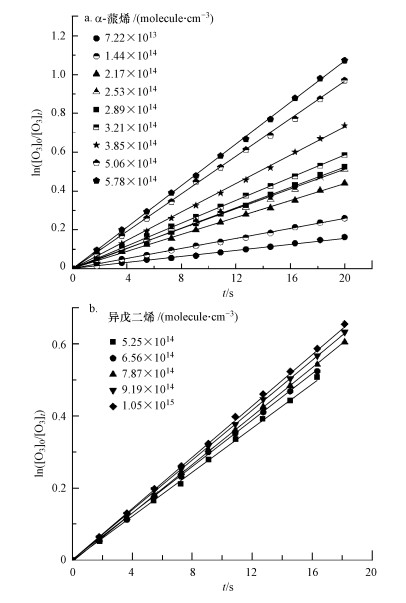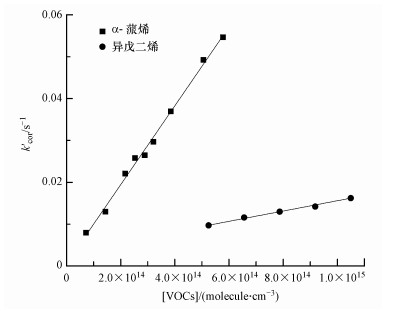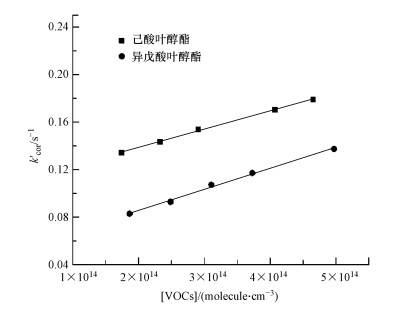2. 中国科学技术大学, 合肥 230026;
3. 中国科学技术大学环境科学与光电技术学院, 合肥 230031
2. University of Science and Technology of China, Hefei 230026;
3. School of Environmental Science and Optoelectronic Technology, University of Science and Technology of China, Hefei 230031
大量挥发性有机化合物(VOCs)由生物源和人为源直接排放到大气中, 据估计, 全世界生物源挥发性有机物(BVOCs)排放量达1150 Tg·a-1(以C计), 占全球VOCs年排放量的90%(Guenther et al., 1995).当前, 中国也有大量关于BVOCs排放的研究报道(Li et al., 2014; Wang et al., 2016; 谢扬飏等, 2007; 郑君瑜等, 2009).BVOCs多为短寿命、高化学活性的不饱和物质, 很容易与大气中的·OH、·NO3和O3等活性氧化剂反应形成过氧自由基.过氧自由基进一步反应一方面可促进NO向NO2的转化, 导致O3浓度的累积, 另一方面生成的低挥发性物质则易于形成二次有机气溶胶, 对空气质量和人体健康都可能产生重要影响.另外, BVOCs也是大气中碳氢化合物的重要贡献者, 其光化学降解对全球碳循环具有重要影响(Andreae et al., 1997; Atkinson et al., 2003; Fu et al., 2012; 石明洁等, 2008; 伏晴艳等, 2013; 李莹莹等, 2011).
绿叶挥发物(Green leaf volatiles, GLVs)是BVOCs的重要组成部分, 主要包括一系列C5和C6的醇、醛、酯等, 在植物细胞内通过脂肪酸的转化而产生, 在植物生长发育过程中或是在外界刺激作用下被大量排放到大气中(Nakamura et al., 2016).作为绿叶挥发物的代表, 叶醇酯类物质近年来被广泛检测到.例如, 乙酸叶醇酯是植物排放物中的主要成分之一(Arey et al., 1991; König et al., 1995; Jardine et al., 2012), 有时甚至占到总排放量的40%以上(Kirstine et al., 1998; Brilli et al., 2012).除乙酸叶醇酯外, 甲酸叶醇酯、丁酸叶醇酯及异戊酸叶醇酯等也被认为对总BVOCs排放量有显著贡献(Maja et al., 2015).另外, 乙酸叶醇酯和异戊酸叶醇酯等还被广泛应用于化妆品和香水香精中, 从而进一步增加了这类物质的排放(张卫卫, 2014).
与·OH的反应被认为是大多数VOCs在大气中的主要消除途径.对于常见的不饱和VOCs, 虽然它们与O3的反应速率比其与·OH反应速率慢约6个数量级, 但通常大气中臭氧浓度要比·OH浓度高5~7个数量级, 因此, 与臭氧的反应也可能是这些活性VOCs在大气中的重要消除途径, 尤其是在污染严重的地区(Atkinson et al., 2003; Al Mulla et al., 2010).Atkinson等(1995)对乙酸叶醇酯与·OH和O3的反应进行研究, 测得反应速率常数分别为(7.84±1.64)×10-11和(5.4±1.4)×10-17 cm3·molecule-1·s-1, 从而证明了与臭氧的反应也是乙酸叶醇酯不可忽略的一个大气消除途径.
本研究利用搭建的流动反应系统对两种重要的BVOCs—异戊酸叶醇酯和己酸叶醇酯与O3的反应动力学进行研究, 获得两个反应的速率常数.研究结果可用于评估大气中这些酯的化学寿命、主要去除途径及影响区域, 同时也可作为大气化学模型的输入数据, 用于更准确的空气质量预测.
2 实验部分(Experimental section) 2.1 实验仪器及方法实验基于石英流动管开展, 实验装置如图 1所示.流动管由静管(内径36 mm, 长100 cm)和动管(内径4 mm, 长120 cm)两部分组成.特定浓度的臭氧和VOCs事先通过配气系统通入两个Teflon气袋中, 由流动管后端的隔膜泵(GM-1.0A, 天津津腾)提供动力, 臭氧和VOCs气流分别经动管和静管进入流动管反应区进行反应, 流量计控制两路气体的流量分别为0.5和1.6 L·min-1.动管末端设计有一系列发散排布的小孔用于反应气流的快速混合.通过电动位移台(SC300-1B, 卓立汉光)控制动管在水平位置上前后移动从而改变反应区域长度.动管在某处位置时对应的反应时间由反应区域长度和流动管内气体流速计算得到.经计算系统内的流体流速为3.44 cm·s-1, 雷诺数约为90, 对应于层流条件(Zhang et al., 2018).反应区长度为0~80 cm, 对应流动管内反应时间为0~25 s.VOCs的初始浓度可由气袋内浓度和反应气流量计算得到, 臭氧浓度由反应区末端的臭氧分析仪(Model 49i, Thermo Scientific)测量得到.实验在298 K和1.01×105 Pa条件下进行, 所有实验至少重复2次.
 |
| 图 1 流动管实验流程图 Fig. 1 Schematic of the experimental setup |
反应速率常数在准一级近似条件下利用绝对速率法进行测量(汪海涛等, 2007; Chen et al., 2016; Lin et al., 2016; Zhang et al., 2016).当VOCs与O3共存时, 体系内O3的损耗有壁损失和与VOCs反应两种途径, 此时臭氧在不同时刻的浓度可以表示为:

|
(1) |
式中, ki是待求的VOCs与O3的反应速率常数(cm3·molecule-1·s-1), kW是臭氧在流动管内的壁损失速率常数(s-1).当VOCs浓度远大于O3浓度时([VOCs]0 > 50[O3]0), 反应过程中可以认为VOCs的浓度保持不变, 于是:

|
(2) |

|
(3) |
式中, k′代表准一级反应的速率常数(s-1).利用臭氧分析仪检测反应不同时间的臭氧浓度, 通过公式(2)获得k′, 进而将k′与不同的[VOCs]0进行线性拟合(式(3)), 所得直线的斜率即为所求的反应速率常数ki值.
2.3 实验试剂异戊酸叶醇酯(98%)和己酸叶醇酯(99%)由Adamas公司提供;α-蒎烯(98%)和异戊二烯(99%)由Alfa Asaer公司生产;环己烷(≥99.5%)作为反应中的·OH清除剂, 购自国药集团化学试剂有限公司.实验所用背景气为零空气, 由一套零空气发生器(AADCO, 737-15)提供.O3由氧气或者零空气通过一台放电臭氧发生器(COM-AD-01, ANSEROS, Germany)产生.
3 结果与讨论(Results and discussion)实验开始前, 利用气相色谱(GC-FID, 7820A, Agilent Technologies)对无O3时通过流动管的VOCs浓度进行连续测量, 发现此时VOCs在系统内的壁损失可以忽略不计.另外, 研究表明, O3与不饱和VOCs的反应中会有·OH产生(Johnson et al., 2008), 通常实验中会加入过量的环己烷作为·OH清除剂(Du et al., 2007; Gai et al., 2009).本文中开展了有无环己烷作为·OH清除剂的对比实验, 发现实验结果并没有任何改变.实际上, 为了保证实验在准一级条件下进行, 文中所用的VOCs浓度远远高于O3浓度, 因此, 实验中生成的少量·OH所造成的VOCs浓度的改变完全可以忽略.
3.1 系统可靠性测试为了验证实验装置和方法的可靠性, 首先对α-蒎烯和异戊二烯与O3的反应速率常数进行测量.O3的初始浓度为(0.73~2.21)×1012 molecule·cm-3, α-蒎烯和异戊二烯的初始浓度分别为(0.72~5.78)×1014和(5.25~10.50)×1014 molecule·cm-3.在不同初始浓度条件下, 利用臭氧分析仪监测反应过程中O3浓度随动管在不同位置(对应于反应不同时间)的变化, 可以得到不同初始有机物浓度条件下反应的准一级曲线, 结果如图 2所示.图中每条直线线性关系都很好, 直线的斜率即为反应的准一级速率常数k′.
 |
| 图 2 不同初始浓度的α-蒎烯(a)和异戊二烯(b)与O3的准一级反应速率曲线 Fig. 2 Pseudo-first-order plots for O3 reactions with different concentrations of α-pinene (a) and isoprene (b) |
所得的准一级速率常数k′可能受到流动管内轴向和径向扩散过程的影响(Chen et al., 2015), 因此, 需要对实验测得的准一级速率常数值k′进行扩散校正:

|
(4) |
式中, k′为实验获得的准一级反应速率常数(s-1), r为流动管静管内半径(cm), v为平均线速度(cm·s-1), D为O3在空气中的扩散系数, 在298 K和1.01×105 Pa条件下D约为0.169 cm2·s-1(Massman, 1998).计算结果显示, 所有k′的校正系数都在1.01~1.03之间, 表明在本实验条件下O3的扩散过程对反应速率的影响可以忽略.为保证更加准确, 接下来的数据处理过程依然使用的是校正后的准一级速率常数k′cor.
将得到的一系列准一级速率常数k′cor与对应的初始VOCs浓度进行线性拟合, 结果如图 3所示, 图中直线斜率即为反应的速率常数值.最终得到α-蒎烯和异戊二烯与O3反应的速率常数分别为(9.42±1.18)×10-17和(1.23±0.15)×10-17 cm3·molecule-1·s-1.文献中国际纯粹与应用化学联合会(IUPAC)给出的这两个反应的速率常数的推荐值分别为9.4×10-17和1.27×10-17 cm3·molecule-1·s-1(Atkinson et al., 2006), 与本研究结果非常符合, 从而表明实验装置和方法的可靠性.
 |
| 图 3 α-蒎烯和异戊二烯与O3的反应速率曲线 Fig. 3 Plots of the pseudo-first-order rate constants vs initial concentrations of α-pinene and isoprene |
在上述流动反应装置中, 进一步测量了异戊酸叶醇酯和己酸叶醇酯与臭氧反应的速率常数.实验中异戊酸叶醇酯和己酸叶醇酯的初始浓度分别为(1.86~4.97)×1014和(1.74~4.65)×1014 molecule·cm-3, O3的初始浓度为(0.83~3.62)×1012 molecule·cm-3.用臭氧分析仪记录动管在不同位置时的臭氧浓度, 获得反应的准一级速率曲线(图 4), 所得的准一级速率常数k′同样用公式(4)进行扩散校正.两种叶醇酯在不同初始浓度条件下获得的准一级速率常数平均值、扩散校正值及其校正系数列于表 1.两种叶醇酯的扩散校正系数在1.03~1.06之间, 表明扩散过程在此实验中的影响同样可以忽略.以k′cor和叶醇酯的初始浓度值进行线性拟合(图 5), 图中斜率值即为待求的异戊酸叶醇酯和己酸叶醇酯与O3的反应速率常数值.实验中误差主要来自多组数据平均时的标准偏差和实验系统误差两部分, 其中, 系统误差主要包括臭氧浓度测量时的误差、VOCs初始浓度计算所产生的误差、流动管内流量测量的可能误差及其它可能的误差, 经估算该部分误差在10%左右(Zhang et al., 2018).最终得到两个反应的速率常数分别为(1.78±0.24)×10-16 cm3·molecule-1·s-1(异戊酸叶醇酯)、(1.54±0.18)×10-16 cm3·molecule-1·s-1(己酸叶醇酯).
 |
| 图 4 不同初始浓度的异戊酸叶醇酯(a)和己酸叶醇酯(b)与O3的准一级反应速率曲线 Fig. 4 Pseudo-first-order plots for O3 reactions with different concentrations of cis-3-hexenyl isovalerate(a) and cis-3-hexenyl hexanoate(b) |
| 表 1 两种叶醇酯在不同初始浓度条件下的准一级反应速率值及其扩散校正系数 Table 1 Pseudo-first-order rate constants and their corresponding correction factors under different initial concentrations for the two studied esters |
 |
| 图 5 异戊酸叶醇酯和己酸叶醇酯与O3的反应速率曲线 Fig. 5 Plots of the pseudo-first-order rate constants vs initial concentrations of the studied esters |
关于异戊酸叶醇酯和己酸叶醇酯与O3的反应速率常数, 文献中未见有报道.研究组前期测定了另外4种叶醇酯与O3的反应速率常数, 可以与本文中研究结果进行类比, 相关结果列于表 2中.臭氧与不饱和物质的反应是通过臭氧对双键的亲电加成进行的, 双键上电子云密度的大小直接影响到反应进行的难易程度(Atkinson et al., 2003; Dang et al., 2015).具有吸电子效应的酯基团—OC(O)R会使双键上电子云密度降低, 而其中的R基团又可以减弱酯基团的这种吸电子效应.因此, 如表 2所示, 除了带有支链的异戊酸叶醇酯外, 从甲酸叶醇酯、乙酸叶醇酯、丙酸叶醇酯、丁酸叶醇酯到己酸叶醇酯, 随着R基团从—H、—CH3、—CH2CH3、—(CH2)2CH3到—(CH2)4CH3, 酯基团的吸电子效应越来越弱, 这些叶醇酯与臭氧的反应速率逐渐变大.异戊酸叶醇酯比丁酸叶醇酯多一个甲基, 反应速率也明显较高, 但其反应速率甚至比己酸叶醇酯还高, 可能是由于存在支链—CH3的原因.
| 表 2 一系列叶醇酯与O3反应速率常数对比 Table 2 Comparison of the rate constants for reactions of O3 with a series of cis-3-hexenyl esters at 298 K and atmospheric pressure |
利用所得速率常数可以估算两种叶醇酯在对流层大气中与臭氧反应的平均寿命τ, 公式为:τ=1/(k[X]), 其中, [X]在本文中表示大气O3浓度, k为所测得的反应速率常数.估算结果见表 3.由表中可见, 两种叶醇酯的大气寿命都在2~3 h.·OH和·NO3作为白天和夜间大气中的主要氧化剂, 它们与异戊酸叶醇酯和己酸叶醇酯的反应速率未见有报道.Rodriguez等(2015)研究了甲酸叶醇酯与·OH的反应, 估算对应的大气寿命为6 h.Atkinson等(1995)测量了乙酸叶醇酯与·OH和·NO3的反应速率常数, 对应的大气寿命分别为2.2 h和2.3 h.Zhang等(2018)对一系列叶醇酯与臭氧的反应研究发现, 这些叶醇酯与O3的反应完全可以与·OH和·NO3的反应相竞争, 是这些叶醇酯在大气中的主要去除方式之一.需要说明的是, 表 3中所用O3浓度值仅是偏远地区的大气背景浓度值7×1011 molecule·cm-3 (约28 ppb)(Logan, 1985).而在某些城市地区或者污染地区, O3浓度常常超过150 ppb(Ding et al., 2013; Ma et al., 2016; Shi et al., 2015; Xu et al., 2011), 甚至到200 ppb以上(Wang et al., 2017; Guo et al., 2009; Lu et al., 2010; Xue et al., 2014).这种情况下, 与O3的反应对于这些叶醇酯在大气中的降解去除将变得更加重要.
| 表 3 利用所测速率常数估算得到的叶醇酯的大气化学寿命 Table 3 Estimated tropospheric lifetimes (τ) for the studied cis-3-hexenyl esters with respect to reactions with O3 |
由上可知, 几种叶醇酯的大气寿命都非常短, 也就意味着这类物质一经排放, 在排放源附近即可被氧化降解.而臭氧与这些不饱和物质的反应通常会产生一些醛、酮或者酯类物质, 这些产物可能会对二次有机气溶胶甚至光化学烟雾的形成起到重要的作用.因此, 这些产物的降解过程及其影响接下来需要开展进一步的研究.
4 结论(Conclusions)1) 利用搭建的流动反应装置, 测得在298 K和1.01×105 Pa条件下O3与α-蒎烯和异戊二烯的反应速率常数分别为(9.42±1.18)×10-17和(1.23±0.15)×10-17 cm3·molecule-1·s-1.该值与IUPAC推荐值在误差范围内非常吻合, 表明本实验装置和实验方法的可靠性.
2) 在准一级条件下, 利用绝对速率法首次测得了两种重要的生物源VOCs异戊酸叶醇酯和己酸叶醇酯与O3的反应速率常数, 分别为(1.78±0.24)×10-16和(1.54±0.18)×10-16 cm3·molecule-1·s-1.
3) 通过估算大气寿命发现, 与O3的反应是异戊酸叶醇酯和己酸叶醇酯在大气中不可忽略的去除途径之一, 在O3浓度较高的城市区域或者其它污染区域, 该反应的作用更加重要.另外, 非常短的大气寿命意味着这类物质在排放源附近即可被氧化降解, 因此, 氧化产物的后续降解过程和大气影响需要进一步开展系统性研究.
Al Mulla I, Viera L, Morris R, et al. 2010. Kinetics and mechanisms for the reactions of ozone with unsaturated oxygenated compounds[J]. Chem Phys Chem, 11(18): 4069–4078.
DOI:10.1002/cphc.v11.18
|
Andreae M O, Crutzen P J. 1997. Atmospheric aerosols:biogeochemical sources and role in atmospheric chemistry[J]. Science, 276(5315): 1052–1058.
DOI:10.1126/science.276.5315.1052
|
Arey J, Winer A M, Atkinson R, et al. 1991. The emission of (Z)-3-hexen-1-ol, (Z)-3-hexenylacetate and other oxygenated hydrocarbons from agricultural plant species[J]. Atmospheric Environment, 25A: 1063–1075.
|
Atkinson R, Arey J. 2003. Gas-phase tropospheric chemistry of biogenic volatile organic compounds:a review[J]. Atmospheric Environment, 37: S197–S219.
DOI:10.1016/S1352-2310(03)00391-1
|
Atkinson R, Arey J, Aschmann S M, et al. 1995. Rate constants for the gas-phase reactions of cis-3-hexen-1-ol, cis-3-hexenylacetate, trans-2-hexenal, and linalool with OH and NO3 radicals and O3 at 296±2 K, and OH radical formation yields from the O3 reactions[J]. International Journal of Chemical Kinetics, 27: 941–955.
DOI:10.1002/kin.v27:10
|
Atkinson R, Baulch D L, Cox R A, et al. 2006. Evaluated kinetic and photochemical data for atmospheric chemistry:Volume Ⅱ-gas phase reactions of organic species[J]. Atmospheric Chemistry and Physics, 6: 3625–4055.
DOI:10.5194/acp-6-3625-2006
|
Brilli F, Hortnagl L, Bamberger I, et al. 2012. Qualitative and quantitative characterization of volatile organic compound emissions from cut grass[J]. Environmental Science & Technology, 46(7): 3859–3865.
|
Chen H, Ren Y, Cazaunau M, et al. 2015. Rate coefficients for the reaction of ozone with 2-and 3-carene[J]. Chemical Physics Letters, 621: 71–77.
DOI:10.1016/j.cplett.2014.12.056
|
Chen Y, Wang J, Zhao S P, et al. 2016. An experimental kinetic study and products research of the reactions of O3 with a series of unsaturated alcohols[J]. Atmospheric Environment, 145: 455–467.
DOI:10.1016/j.atmosenv.2016.09.057
|
Dang J, Shi X L, Zhang Q Z, et al. 2015. Mechanism and thermal rate constant for the gas-phase ozonolysis of acenaphthylene in the atmosphere[J]. Science of the Total Environment, 514: 344–350.
DOI:10.1016/j.scitotenv.2014.12.009
|
Ding A J, Fu C B, Yang X Q, et al. 2013. Ozone and fine particle in the western Yangtze River Delta:an overview of 1 yr data at the SORPES station[J]. Atmospheric Chemistry and Physics, 13: 5813–5830.
DOI:10.5194/acp-13-5813-2013
|
Du L, Xu Y F, Ge M F. 2007. Rate constant for the reaction of ozone with diethyl sulfide[J]. Atmospheric Environment, 41: 7434–7439.
DOI:10.1016/j.atmosenv.2007.05.041
|
伏晴艳, 余瑭, 陆涛, 等. 2013. 植物排放与空气污染[J]. 园林, 2013(6): 32–35.
|
Fu Y, Liao H. 2012. Simulation of the interannual variations of biogenic emissions of volatile organic compounds in China:Impacts on tropospheric ozone and secondary organic aerosol[J]. Atmospheric Environment, 59: 170–185.
DOI:10.1016/j.atmosenv.2012.05.053
|
Gai Y B, Ge M F, Wang W G. 2009. Kinetic studies of O3 reactions with 3-bromopropene and 3-iodopropene in the temperature range 288-328 K[J]. Atmospheric Environment, 43: 3467–3471.
DOI:10.1016/j.atmosenv.2009.04.038
|
Guenther A, Hewitt C N, Erickson D, et al. 1995. A global model of natural volatile organic compound emissions[J]. Journal of Geophysical Research:Atmospheres, 100(D5): 8873–8892.
DOI:10.1029/94JD02950
|
Guo H, Jiang F, Cheng H R, et al. 2009. Concurrent observations of air pollutants at two sites in the Pearl River Delta and the implication of regional transport[J]. Atmospheric Chemistry and Physics, 9: 7343–7360.
DOI:10.5194/acp-9-7343-2009
|
Jardine K, Barron-Gafford G A, Norman J P, et al. 2012. Green leaf volatiles and oxygenated metabolite emission bursts from mesquite branches following light-dark transitions[J]. Photosynthesis Research, 113(1/3): 321–333.
|
Johnson D, Marston G. 2008. The gas-phase ozonolysis of unsaturated volatile organic compounds in the troposphere[J]. Chemical Society Reviews, 37: 699–716.
DOI:10.1039/b704260b
|
Kirstine W, Galbally I, Ye Y, et al. 1998. Emissions of volatile organic compounds (primarily oxygenated species) from pasture[J]. Journal of Geophysical Research:Atmospheres, 103(D9): 10605–10619.
DOI:10.1029/97JD03753
|
König G, Brunda M, Puxbaum H, et al. 1995. Relative contribution of oxygenated hydrocarbons to the total biogenic VOC emissions of selected mid-European agricultural and natural plant species[J]. Atmospheric Environment, 29(8): 861–874.
DOI:10.1016/1352-2310(95)00026-U
|
Li L Y, Xie S D. 2014. Historical variations of biogenic volatile organic compound emission inventories in China, 1981-2003[J]. Atmospheric Environment, 95: 185–196.
DOI:10.1016/j.atmosenv.2014.06.033
|
李莹莹, 李想, 陈建民. 2011. 植物释放挥发性有机物(BVOC)向二次有机气溶胶(SOA)转化机制研究[J]. 环境科学, 2011, 32(12): 3588–3592.
|
Lin X X, Ma Q, Yang C Q, et al. 2016. Kinetics and mechanisms of gas phase reactions of hexenols with ozone[J]. RSC Advances, 87: 83573–83580.
|
Logan J A. 1985. Tropospheric ozone:seasonal behavior, trends, and anthropogenic influence[J]. Journal of Geophysical Research, 90: 10463–10482.
DOI:10.1029/JD090iD06p10463
|
Lu K D, Zhang Y H, Su H, et al. 2010. Regional ozone pollution and key controlling factors of photochemical ozone production in Pearl River Delta during summer time[J]. Science China Chemistry, 53: 651–663.
DOI:10.1007/s11426-010-0055-6
|
Ma Z Q, Xu J, Quan W J, et al. 2016. Significant increase of surface ozone at a rural site, north of eastern China[J]. Atmospheric Chemistry and Physics, 16: 3969–3977.
DOI:10.5194/acp-16-3969-2016
|
Maja M M, Kasurinen A, Holopainen T, et al. 2015. Volatile organic compounds emitted from silver birch of different provenances across a latitudinal gradient in Finland[J]. Tree physiology, 35(9): 975–986.
DOI:10.1093/treephys/tpv052
|
Massman W J. 1998. A review of the molecular diffusivities of H2O, CO2, CH4, CO, O3, SO2, NH3, N2O, NO, and NO2, in air, O2, and N2, near STP[J]. Atmospheric Environment, 32(6): 1111–1127.
DOI:10.1016/S1352-2310(97)00391-9
|
Nakamura Y, Li-Beisson Y. 2016. Lipids in Plant and Algae Development[M]. Switzerland: Springer: 427–443.
|
Rodriguez D, Rodriguez A, Bravo I, et al. 2015. Kinetic study of the gas-phase reactions of hydroxyl radicals and chlorine atoms with cis-3-hexenylformate[J]. International Journal of Environmental Science and Technology, 12: 2881–2890.
DOI:10.1007/s13762-014-0686-9
|
Shi C Z, Wang S S, Liu R, et al. 2015. A study of aerosol optical properties during ozone pollution episodes in 2013 over Shanghai, China[J]. Atmospheric Research, 153: 235–249.
DOI:10.1016/j.atmosres.2014.09.002
|
石明洁, 延晓冬, 贾根锁. 2008. 生物挥发性有机物研究进展[J]. 地球科学进展, 2008, 23(8): 866–873.
|
汪海涛, 朱红霞, 曾鸣, 等. 2007. 臭氧与二甲硫醚和乙烯的反应速率常数测定[J]. 环境科学学报, 2007, 27(5): 775–778.
|
Wang X M, Situ S P, Chen W H, et al. 2016. Numerical model to quantify biogenic volatile organic compound emissions:The Pearl River Delta region as a case study[J]. Journal of Environmental Sciences, 46: 72–82.
DOI:10.1016/j.jes.2015.08.032
|
Wang T, Xue L, Brimblecombe P, et al. 2017. Ozone pollution in China:A review of concentrations, meteorological influences, chemical precursors, and effects[J]. Science of The Total Environment, 575: 1582–1596.
DOI:10.1016/j.scitotenv.2016.10.081
|
谢扬飏, 邵敏, 陆思华, 等. 2007. 北京市园林绿地植被挥发性有机物排放的估算[J]. 中国环境科学, 2007, 27(4): 498–502.
|
Xu J, Ma J Z, Zhang X L, et al. 2011. Measurements of ozone and its precursors in Beijing during summertime:impact of urban plumes on ozone pollution in downwind rural areas[J]. Atmospheric Chemistry and Physics, 11: 12241–12252.
DOI:10.5194/acp-11-12241-2011
|
Xue L K, Wang T, Gao J, et al. 2014. Ground-level ozone in four Chinese cities:precursors, regional transport and heterogeneous processes[J]. Atmospheric Chemistry and Physics, 14: 13175–13188.
DOI:10.5194/acp-14-13175-2014
|
Zhang Q, Chen Y, Tong S R, et al. 2017. Atmospheric oxidation of selected chlorinated alkenes by O3, OH, NO3 and Cl[J]. Atmospheric Environment, 170: 12–21.
DOI:10.1016/j.atmosenv.2017.09.031
|
Zhang Q L, Lin X X, Gai Y B, et al. 2018. Kinetic and mechanism study on gas phase reactions of ozone with a series of cis-3-hexenyl esters[J]. RSC Advances, 8: 4230–4238.
DOI:10.1039/C7RA13369C
|
张卫卫. 2014. 乙酸叶醇酯生产工艺研究及中试设计[D]. 秦皇岛: 燕山大学
http://cdmd.cnki.com.cn/Article/CDMD-10216-1014041224.htm |
郑君瑜, 郑卓云, 王兆礼, 等. 2009. 珠江三角洲天然源VOCs排放量估算及时空分布特征[J]. 中国环境科学, 2009, 29(4): 345–350.
|
 2018, Vol. 38
2018, Vol. 38


